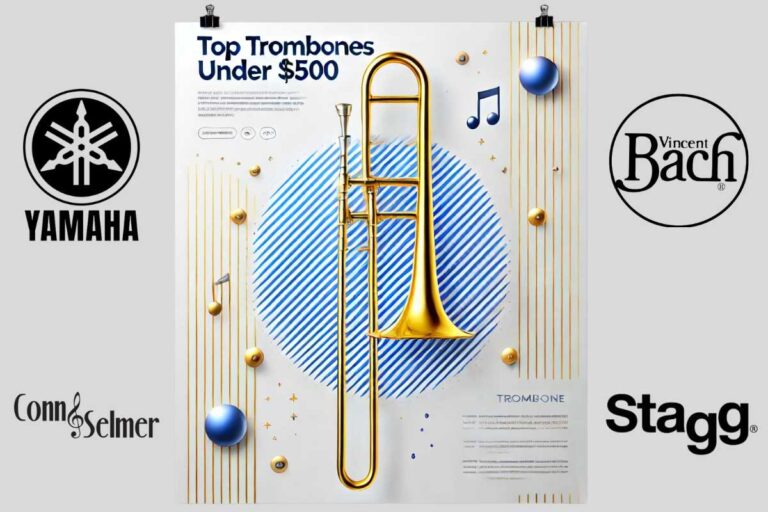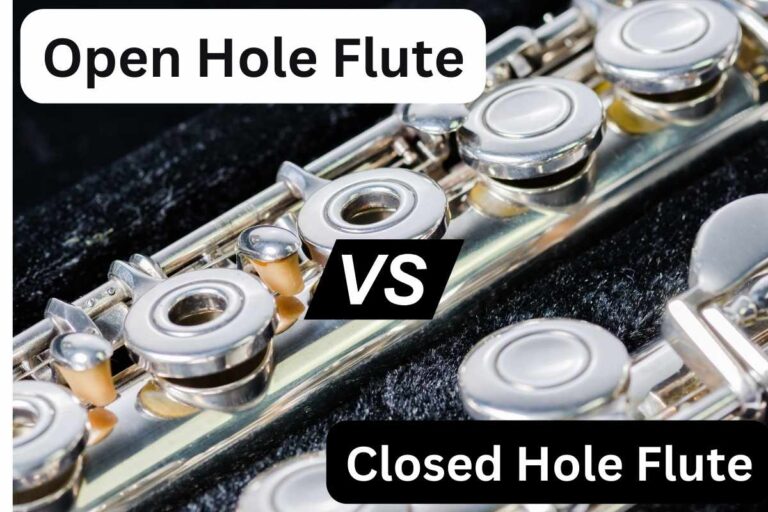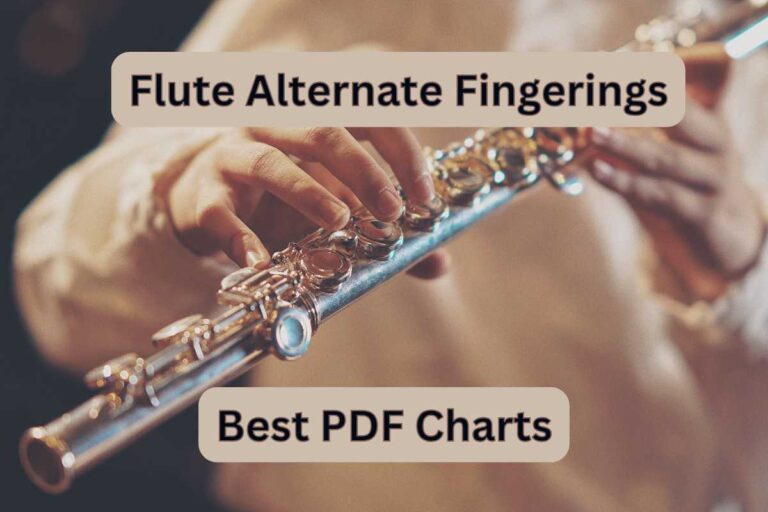Trombone For Beginners — A Comprehensive Brass Guide for Beginners To Play The Trombone in 2025

Hey there, future trombonists! I’m Eugene, and I’ve been selling trombones (and other brass instruments) for over 15 years. This guide is your ticket to the best trombone for beginners in 2025!!
Trust me, I’ve seen everything — from total newbies on rusty ( and smelly 🤢) trombones to budding virtuosos with custom horns.
Why read on? Simple — You’ll get insider tips, avoid common pitfalls, and fast-track your way to trombone greatness. Plus, I’ll share some real success stories that inspire you to stick with it (pun intended).
So, grab your horn (if you have one), and let’s dive in. By the end of this guide, you’ll be well on your way to impressing your friends, family, and maybe even a few professional musicians. Ready to embark on your trombone journey? Let’s slide right in!
Discovering the Trombone — Your Gateway to Brass Mastery
Ah, the trombone – the rebel of the brass family. (It’s the only one without valves — how cool is that?) This bad boy has been around since the 15th century, evolving from its early form as a “sackbut” (yeah, I giggled too when I first heard that).
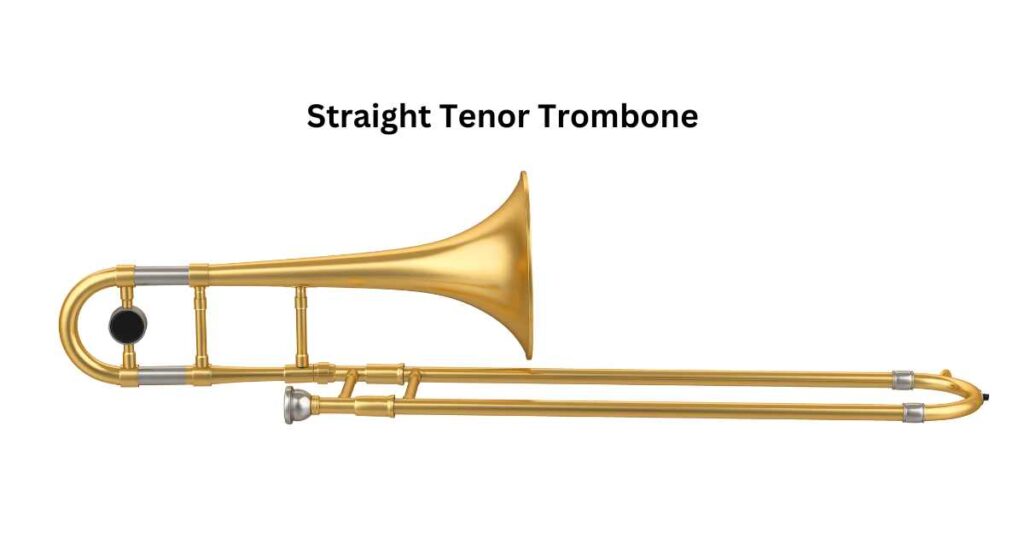
What makes the trombone special? It’s all about that SLIDE, baby! Unlike its valve-y cousins, the trombone uses a slide to change pitch. This unique feature gives it incredible flexibility in pitch and tone.
From classical orchestras to jazz ensembles and even rock bands — the trombone’s versatility is off the charts! It belts out powerful, brassy tones or whispers sweet, mellow melodies. (Ever heard a trombone in a ska band? It’s like a party in your ears!)

For beginners, the trombone is a fantastic choice. Why? It’s relatively easy to produce a sound (unlike the French horn, which is a real BEAST), and the slide positions are visually easy to understand. Plus, let’s be honest, it just looks cool. Who doesn’t want to be the one with the “long, slidey thing” in the band?
Selecting Your Perfect Beginner Trombone: A Comprehensive Guide
Alright, let’s talk brass. When it comes to beginner trombones, you’ve got some solid options. Brands like Yamaha, Bach, and King are the holy trinity of beginner trombones. They’re like the Beyoncé, Adele, and Taylor Swift of the trombone world – reliable, high-quality, and always deliver a great performance.
[For more info on trombone brands, check out the International Trombone Association]
Now, here’s a pro tip: always TRY before you buy (especially second-hand horns). It’s like dating — you wouldn’t marry someone without going on a few dates first, right? Same goes for trombones. Each one has its own personality, and you need to find the one that vibes with you.
Budget-wise, expect to shell out anywhere from $500 to $1500 for a decent beginner trombone. Yeah, I know, it’s not pocket change, but think of it as an investment in your future rockstar status. (Read my other post on the “Trombone Price Guide – 5 Price Levels”)
3 Student Trombone Brands
| Brand | Price Range | Known For |
| Yamaha | $700-$2000 |
|
| Bach | $800-$1800 |
|
| King | $600-$1500 |
|
Warning: Avoid those super cheap trombones you might find online (on Amazon or eBay). They’re the musical equivalent of a fast-food burger – might look okay, but you’ll REGRET it later. Stick with reputable brands and dealers. Your future self (and your neighbors) will thank you!!
Student Trombones vs. Pro and Intermediate Models — What’s the Difference?
Okay, let’s talk trombone tiers. Student models are like your first car – reliable, gets the job done, but not exactly a Ferrari.
Student Vs. Pro and Intermediate Horns
| Feature | Student Model | Professional Model |
| Material | Yellow brass | Often rose brass or gold brass |
| Bore Size | Smaller (.500"-.525") | Smaller + Larger (.547" or more) |
| Bell | Usually one piece | Often hand-hammered, two-piece |
| Price | $500-$1500 | $3000 and up |
Why start playing with a student model? They’re more forgiving, easier to handle, and won’t break the bank. It’s like learning to drive on an automatic before tackling a stick shift.
When to upgrade? When you’ve outgrown your student horn. Signs include
– Consistently playing at a high level
– Noticing limitations in your current instrument’s sound or range
– Participating in serious ensembles or competitions
Remember, a pro horn WON’T magically make you a pro trombone player. But in the hands of a skilled player, it can make a world of difference.
Renting vs. Buying — Making the Right Choice for Beginner Trombone Player
The eternal question — to rent or to buy? Let’s break it down
New wpDataTable
| Renting | Buying | |
| Pros |
|
|
| Cons |
|
|
My advice? If you’re just starting out, rent for a few months. It’s like dating — you want to make sure you’re compatible before committing. Once you’re sure the trombone is your soulmate (musically speaking) — then consider buying.
Typical rental costs? About $30-50 per month. Buying a beginner (student) trombone? Anywhere from $500 to $1500.
The Pros and Cons of Plastic Trombones for Novice Players
Plastic trombones – the controversial new kid on the block. Let’s dive in.
Plastic trombones pros and cons
Pros
- Lightweight (great for young players or long practice sessions)
- Durable (can take a beating)
- Affordable (usually under $200)
- Fun colors (who doesn’t want a purple trombone?)
Cons
- Sound quality (not as rich or resonant as brass)
- Limited upgrade potential (you’ll outgrow it quickly if you’re serious)
- Not accepted in many ensembles (sorry, no plastic musical instruments in the orchestra)
pBone Music pBone Mini Trombone — Check Price
My take? They’re great for absolute beginners, especially kids. They’re also fantastic for camping trips or outdoor gigs where you don’t want to risk your brass baby.
But if you’re serious about playing, consider them a stepping stone, not a final destination. They’re like training wheels – great to start with, but you’ll want to move on eventually.
Foundational Trombone Techniques for Novices
Okay, newbies, let’s talk technique. There are THREE big things you want to learn and focus on: embouchure, breath support, and slide positions.
Embouchure is fancy talk for how you shape your mouth (and lips) on the mouthpiece. Think of it as making a raspberry sound but with more control. (Go ahead, try it. I’ll wait.)
Breath support is all about using your diaphragm, NOT just your lungs. Imagine you’re trying to blow out a really stubborn birthday candle.
Slide positions? There are seven of them, each corresponding to a different note. Think of it like a trombone GPS – the 1st position is home, the 7th is as far as you can reach.
Here’s a simple exercise to get you started
1. Take a deep breath, filling your belly.
2. Form your embouchure (remember, raspberry face!)
3. Blow steadily while moving the slide from the 1st to the 7th position.
4. Keep the sound consistent throughout.
Pro tip from my idol, Jazz legend J.J. Johnson: “Practice slow to learn fast.” Wise words, J.J., wise words. James Louis NEA Jazz Master interview
Scales and Breathing Techniques — Building Your Trombone Foundation
Alright, let’s talk scales. I know, I know, they’re about as exciting as watching paint dry. But trust me, they’re the vegetables of the music world — not always fun, but essential for growth.
Scales help you develop muscle memory and improve your intonation (that’s fancy talk for playing in tune). Plus, they’re like the building blocks of music. Master your scales, and you’re HALFWAY to master any piece of music!
Here’s a step-by-step guide to practicing your B♭ (B flat) major scale
1. Start in 1st position (that’s your home base)
2. Play Bb (no slide movement needed)
3. Move to 4th position for C
4. Back to 1st for D
5. 3rd position for E-flat
6. 1st position for F
7. 2nd position for G
8. 1st position for A
9. And finally, 4th position for high B-flat
Repeat this up and down until it becomes second nature. (And until your family begs you to play something else!)
Now, let’s talk about breathing. Proper breathing is like the secret sauce of trombone playing — it’s what gives your notes power and sustain.
Here’s a breathing exercise many teachers swear by
1. Lie on your back with a book on your stomach
2. Breathe in deeply, trying to lift the book with your belly
3. Exhale slowly, letting the book sink back down
4. Repeat for 5 minutes daily
Do this, and you’ll be blowing like the Big Bad Wolf in no time!
Developing Your Embouchure and Breath Control
Embouchure — it’s not just fun to say, it’s CRITICAL to master. Think of it as your trombone’s BFF (Best Face Forward).
The muscles around your mouth (and lips) form your embouchure. A good embouchure is firm but relaxed, like a gentle smile. (Imagine you’re trying not to laugh at your teacher’s bad jokes — that’s the perfect embouchure face!)
Here’s an exercise to strengthen your embouchure
1. Make a “pfffft” sound (like you’re unimpressed)
2. Now, tighten the corners of your mouth
3. Try to make the same sound but more focused
4. Do this for 30 seconds, rest, and repeat
Common embouchure mistakes? Oh boy, we’ve seen ’em all. The “puffer fish” (cheeks too puffed out), the “grimace” (too tight), and my personal favorite, the “soggy noodle” (too relaxed). Avoid these, and you’re golden.
Slide Technique Mastery — Tips from Professional Trombonists
Slide techniques are where trombonists separate themselves from the valve-pushing masses. It’s your superpower, your claim to fame, your… okay, you get the idea.

Proper slide technique is all about smoothness and accuracy. You want to move the slide quickly and precisely, like a ninja.
Here’s an exercise to improve your slide accuracy
1. Play a note in 1st position
2. Move quickly to 7th position
3. Try to hit the correct pitch immediately
4. Move back to 1st position
5. Repeat, gradually increasing speed
[For more advanced slide techniques, check out this great resource from Yamaha Music Education]
Pro tip from trombone virtuoso Joseph Alessi: “Think of your slide arm as an extension of your ear. Listen carefully, and your arm will follow.” Joe Alessi master class quotes
Remember, practice makes perfect. Or at least practice makes “pretty darn good,” which is a GREAT start!
Proper Trombone Posture and Handling: A Step-by-Step Guide
Good posture is crucial – it’s the difference between playing for hours comfortably and feeling like you’ve been hit by a truck after 15 minutes.
Here’s your step-by-step guide to trombone posture
1. Stand up straight (imagine a string pulling you up from the top of your head)
2. Feet shoulder-width apart (think “strong stance”)
3. Hold the trombone so the mouthpiece comes naturally to your lips (no neck craning!)
4. Left hand on the slide brace (that’s the part connecting the slide to the bell)
5. Right hand on the slide (grip it gently, like you’re holding a baby bird)
6. Elbows away from your body (give those arms some breathing room!)
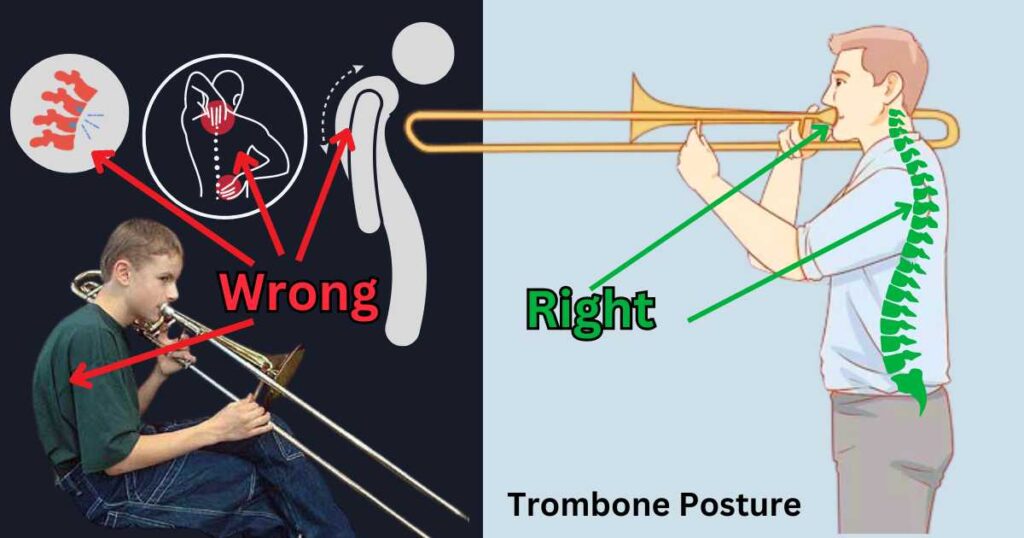
Remember, your trombone should feel like an extension of you, not a heavy weight you’re lugging around. If you’re tensing up, take a break and reset.
Recommended Learning Materials And Trombone Lessons for Beginner Trombonists
Ready to dive deeper into the world of trombone? Here are some resources to get you started:
- Method Books:
- “Essential Elements for Band: Trombone Book 1” (great for beginners)
- “The Arban Complete Method for Trombone” (the trombone bible)
- Online Resources:
- YouTube channels: “Trombone Lessons with Charlie Porter” and “Christopher Bill”
- Websites: tromboneforum.org (great community for asking questions)
- Private Lessons (BEST option):
Finding a qualified instructor fast-tracks your progress. Look for local music schools or ask your band director for recommendations.
Remember, consistency is key. Even 15 minutes of focused practice daily can yield amazing results!
Maintaining Your Trombone: Essential Care and Cleaning Tips
Taking care of your trombone isn’t just about keeping it shiny — it’s about maintaining its sound quality and longevity. Here’s a quick Daily Maintenance guide (Yamaha)
- Wipe down the slide after each use with a lint-free cloth
- Empty water from the spit valve
- Store in a case when not in use
Weekly Cleaning (Houghton Horns).
- Clean the mouthpiece with mild soap and warm water
- Use a cleaning rod with a cloth to clean inside the slide
- Apply slide cream and spray with water for smooth action
Monthly Deep Clean
- Disassemble the trombone (if you’re comfortable doing so)
- Clean all parts with lukewarm, soapy water
- Oil the tuning slides
Essential Supplies
- Slide cream or oil
- Mouthpiece brush
- Cleaning rod
- Lint-free cloths
Remember, a well-maintained trombone is a HAPPY trombone. And a happy trombone makes for a happy trombonist!
Exploring the Trombone Family: From Tenor to Bass Trombone
Alright, let’s talk about the bass trombone – the Barry White of the trombone world. Deep, smooth, and oh so low.
The main difference between tenor and bass trombones? Size and sound. Bass trombones have a larger bore (the inside diameter of the tubing) and a bigger bell. This means they can play lower notes with a richer, fuller sound.
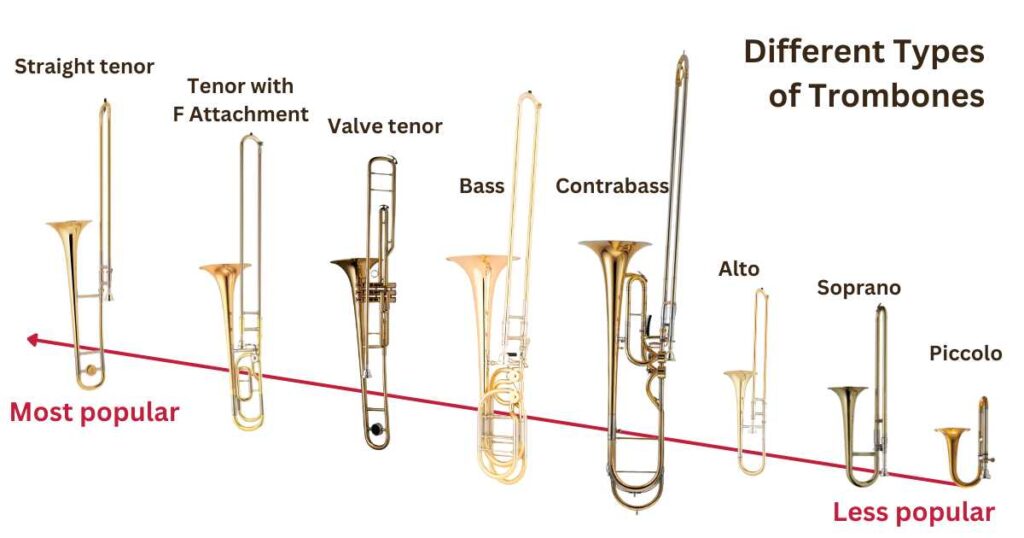
When should you consider switching to bass? Well, it’s not just about being able to play lower notes. Bass trombones require more air and a different approach to playing. It’s like upgrading from a bicycle to a motorcycle — the same basic principle, but a WHOLE new level of power and control. (daunt)
Usually, students can transition to bass trombone after a few years of playing tenor. It’s a natural progression for those who love the low end and have the lung capacity to handle it. (Trust me, playing bass trombone is like trying to inflate a hot air balloon with your mouth!)
The challenges? Well, besides needing lungs like a whale, bass trombones often require learning to use thumb triggers (F attachment and D attachment) for even lower notes. But the rewards? Oh boy. There’s nothing quite like hitting a low note that makes the floor vibrate!
Tenor vs. Alto Trombones: Understanding the Differences
Now, let’s talk about the alto trombone — it’s like the tenor’s smaller cousin with a higher pitch.
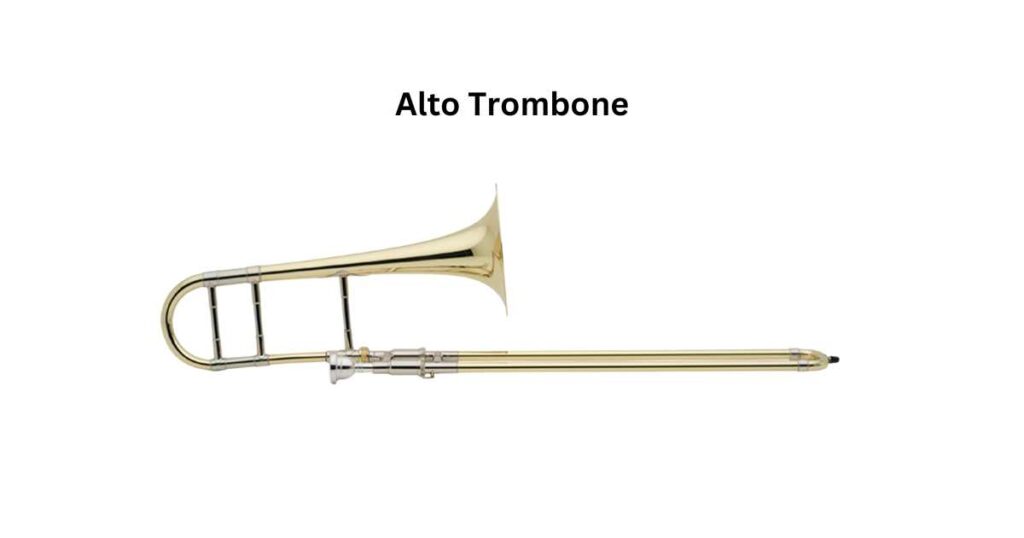
The main difference is size and pitch. Alto trombones are smaller and pitched in E-flat, while tenors are in B-flat. This means alto trombones play higher notes more easily.
Tenor Vs. Alto Trombones Comparison
| Feature | Tenor Trombone | Alto Trombone |
| Pitch | B♭ (B flat) | E♭ (E flat) |
| Size | Larger | Smaller |
| Range | Lower | Higher |
| Common Use | Orchestra, Jazz, Band | Baroque Music, Some Orchestra |
Alto trombones are less common these days, but they’re still used in some classical and baroque music. They’re great for players who want to specialize in high-range playing.
For beginners? Stick with the tenor. It’s more versatile and easier to find. Plus, it’s what most music is written for (sheet music). You can always explore alto later if you decide to dive into baroque music or just want to annoy your dog with really high notes.
Conclusion: Trombone For Beginner Guide And FAQ — Learn To Play The Trombone
Well, future trombone superstar, you’ve made it to the end of our ultimate beginner’s guide! From choosing your first trombone to mastering those tricky slides, we’ve covered a lot of ground.
Remember, every great trombonist started exactly where you are now. The key is to practice regularly, be patient with yourself, and most importantly, have FUN!!!
Don’t be discouraged if you sound more like a dying whale than a smooth jazz player at first… They’ve all been there. (Trust me, most first attempts sound like trying to communicate with extraterrestrial life forms.)
As you continue your trombone journey, keep exploring new music, join ensembles when you can, and never stop learning. Who knows? Maybe one day you’ll be the one writing a beginner’s guide for the next generation of trombonists! (Read and Listen to the “13 Best Trombone Players”)
Now, go forth and slide your way to musical greatness. The world is waiting for your sweet, brassy tones!


